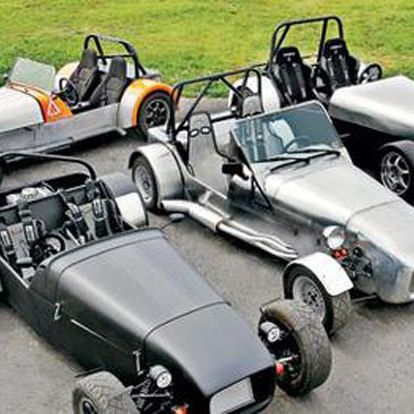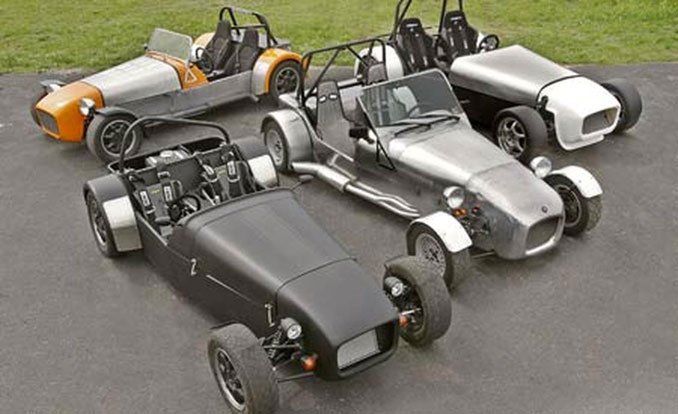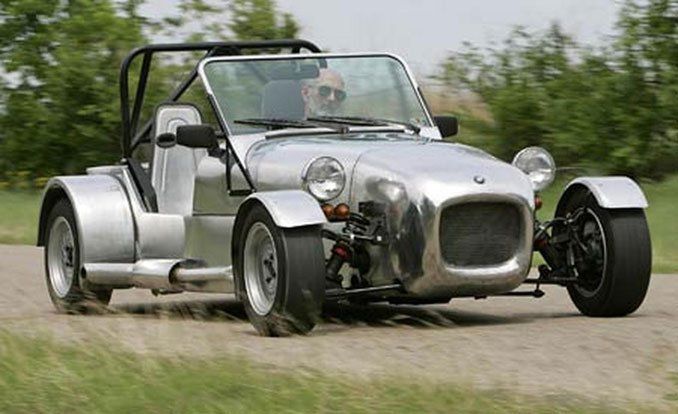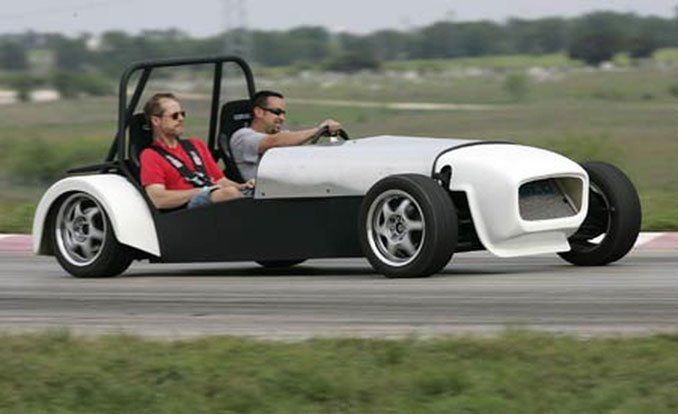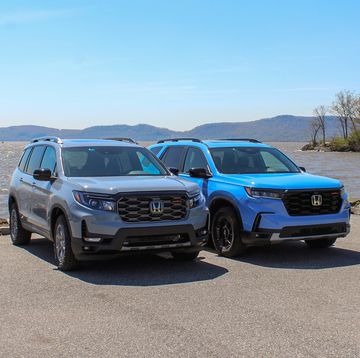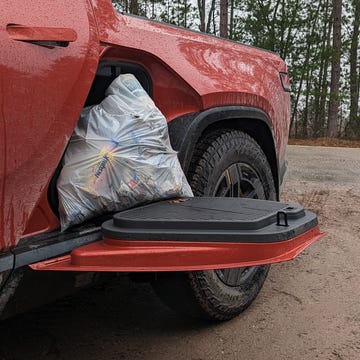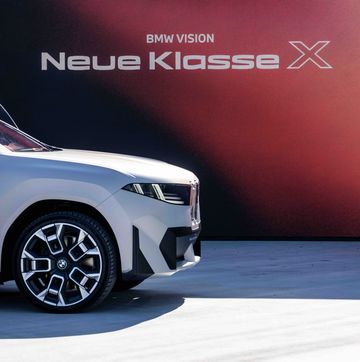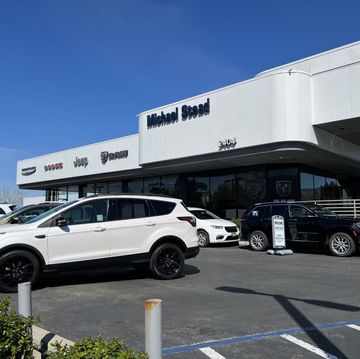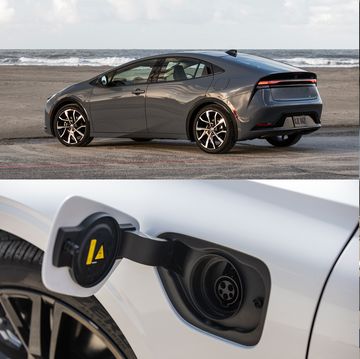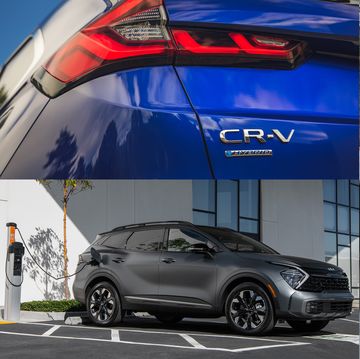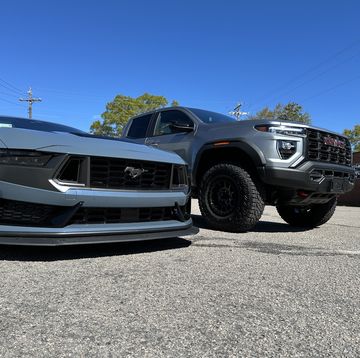Anyone can build a car. Just hire a pro and begin practicing your penmanship for writing zeros on an unending number of personal checks.
Or you can try doing it yourself — and attempt to spend less than 10 grand.
Don't laugh. We recently met up with four guys who have built cars themselves and didn't wind up in bankruptcy or divorce court. One built a car for a few bucks more than the $1400 we forked over not long ago to buy the world's most toxic 1980 Mercedes diesel car [ C/D, April 2006].
There's a good deal of interest these days in back-yard carbuilding, thanks to Ron Champion. In 1996, he wrote a book, Build Your Own Sports Car for as Little as £250. In Yankee greenbacks, that's about $465. The book does show how to build an inexpensive sports car practically from scratch, but more important, it can get a gearhead thinking, "Hey, I could do that!" In England, where the book was published, Champion inspired about 400 would-be Colin Chapmans and Enzo Ferraris to build their own cars. In 10 years, about 60,000 copies of the book have been sold, which is a lot for a how-to book. A third edition is due out next spring with a revised, more realistic title: Build Your Own Sports Car for as Little as £1000. That's about $1800.
Champion's instructions describe a car that looks much like a Lotus 7, and he appropriately named it the Locost (pronounced "low cost"). Cloning the 7 was logical because the Lotus, which first appeared in 1957 (oddly enough as a kit), is probably the most fundamental sports car ever built. It's a lot of fun to drive, and its appeal continues even after five decades—indeed, there are several kit cars for sale today that resemble the original. The most well-known is the Caterham, offered by an English company that bought the rights to the Lotus 7 in 1973. We've test-driven more than a few of them; the Caterham is quick and agile and feels wired to your brain. We'd all have one except they're expensive — a basic model costs more than 30 grand.
Champion, though, says you could build your own Lotus 7-type car for a fraction of what a Caterham goes for. Could that be true?
It's true, but it's not easy. The Locost builders we spoke with all said Champion's $30 book was their inspiration, but by the time they'd finished, they had relied on a lot more resources than the 191-page book.
"The biggest resource by far," says Mark Rivera, a 29-year-old engineer from Lexington, Kentucky, "was other builders I met over the Internet."
There are discussion groups on Yahoo! called Locost and Locost NA (for "North America"). From those starting points, most builders end up at www.mcsorley.net. Run by a 33-year-old engineer from Orlando, Florida, Jim McSorley's site chronicles his odyssey of building a Locost (it's not yet finished) and also has Locost chassis blueprints, build sheets, and downloadable 3-D models. These items make creating the steel-tube chassis easier.
McSorley's downloads are free, which is probably because of the grass-roots nature of the hobby and also because the demand is small. There are several hundred Locosts knocking around England, but here in the U.S., they are just catching on. The problem has been that Champion's book recommends donor parts—engines, transmissions, axles—from cars that are readily available in England but not here.
Several North American companies, however, have begun selling various bits and pieces to simplify the process. Builders can buy frames and parts from places like Deman Motorsport (www.demanmotorsport.com) and Coveland Motorsports. It depends on how much the builder wants to do himself and is willing to spend. For example, a completed frame costs about $2000, but purchased individually, the materials cost less than $500.
Although it is possible to build a Locost for little dough, would the finished product be something you'd want to drive? To find out, we posted a message on the Locost forum and invited builders with finished home-built cars to meet us at an event called the Southwest Se7ens Festival. This annual gathering is held at MotorSport Ranch, a racetrack about 30 miles south of Dallas. We got commitments from four guys, and they all showed up — two with finished cars and two with cars that were running but not quite finished. We did the usual driving and testing and learned that, above all, no two Locosts are the same.
Jon A. Winterhalter
Age: 54
Location: Sinking Spring, Pennsylvania
Occupation: Civil engineer
Build time: 20 months
Money sunk: $2500
Winterhalter, an acknowledged penny pincher, built his car for the least money. He and his younger son, Andrew, fabricated most of the car and used the mechanicals from a 1980 BMW 320i that he picked up for $292. Father and son used drawings from McSorley's Web site and attempted tasks they had never performed before. They learned to weld by watching a 15-minute instructional video that came with their Miller welder.
The signature feature of the car is the curved aluminum nose cone that was shaped by Winterhalter on an English wheel — a difficult-to-master metal-shaping device — he built. The nose alone took 80 hours to complete. Winterhalter became enthralled with sculpting metal, and it shows in his good-looking work. When he retires in two years, that's what he's going to do with his free time — "shape metal."
Although Winterhalter's homemade car is certainly an entertaining piece, it's not really a Caterham substitute. With only 101 horsepower, it's not terribly quick (0 to 60 mph in 7.8 seconds), and the Winterhalters haven't managed to get the suspension working to their satisfaction. The car was darty, and if the driver takes his hands off the wheel for a moment, it veers off-course. We didn't get the predictable behavior from Winterhalter's car that equates with fun driving, even though it pulled an impressive 1.00 g on the skidpad. The car did have its charms: a burbly exhaust note and a slick shifter among them. It would provide plenty of fun on a sunny-day romp through the countryside. For two-and-a-half grand, it's hard to complain about how it works.
Winterhalter said the real value of his car goes beyond the finished product. "The value of the education you get makes the cost of doing it negligible. You could throw the car away and still be far better off." That's not just preaching to the choir. The younger Winterhalter used the build as his senior project in high school and is now studying mechanical engineering at Penn State.
VEHICLE TYPE: front-engine, rear-wheel-drive, 2-passenger, 0-door roadster
PRICE AS TESTED: $2500
ENGINE TYPE: SOHC 8-valve inline-4, iron block and aluminum head, port fuel injection
Displacement: 108 cu in, 1767cc
Power (SAE net): 101 bhp @ 5800 rpm
Torque (SAE net): 100 lb-ft @ 4500 rpm
TRANSMISSION: 5-speed manual
DIMENSIONS:
Wheelbase: 100.0 in Length: 133.0 in Width: 62.0 in Height: 44.0 in
Curb weight: 1460 lb
C/D TEST RESULTS:
Zero to 60 mph: 7.8 sec
Zero to 80 mph: 15.0 sec
Street start, 5-60 mph: 8.5 sec
Standing ¼-mile: 16.1 sec @ 82 mph
Braking, 70-0 mph: 233 ft
Roadholding, 300-ft-dia skidpad: 1.00 g
Mark Rivera
Age: 29
Location: Lexington, Kentucky
Occupation: Project engineer at a sheetmetal contracting firm
Build time: 16 months and counting
Money sunk: $7600
Rivera started his project with what could reasonably be called a blasphemous act: He scavenged his own '94 Miata. He had turbocharged the little Mazda but wanted something even quicker, so he decided to build a lighter car. The original plan was to sell the Miata and use the proceeds for his Locost, but takers failed to appear, so he took a Sawzall to it. The gore is on display at rivera.fotomojo.us/g. Rivera sold the Miata parts he didn't need and nestled the 260-hp turbocharged Miata powerplant into an enlarged chassis he constructed himself. He used the McSorely 7+442 design, which is basically a Locost with a roomier passenger compartment and engine bay.
It's comfortably spacious in the driver's seat, but at 1497 pounds, it's the heaviest car of this group. Part of the weight can be pinned on the luxury of power steering and the extra hardware of the turbocharging system.
The car still had plenty of mojo. It blasts to 60 mph in only 4.1 seconds — that's as fast as a Corvette. Since the car is so light, there was still plenty of punch when the engine was off boost.
We quite enjoyed the thrust of this car as it zinged up and down the drag strip during testing. Toward the end of the session, it started to veer noticeably off-course with just a small tug on the steering wheel, and we had a hard time keeping it from ping-ponging off the concrete barrier walls. We did a few quick laps on the skidpad, where the Rivera car plowed dramatically at a disappointingly low 0.86 g, so we pulled into the pits.
The problem was obvious — the front wheels were pointing in different directions. On inspection, Rivera noticed that the lower-control arms had bent, which drastically threw off the alignment.
He'll have to make those pieces a little stronger. We should note that Rivera is an avid reader who worked feverishly for 30 days to complete his car so it could make it into this story. We suspect he loves Car and Driver so much that he figured he could worm a staff job by killing off an editor on the track.
VEHICLE TYPE: front-engine, rear-wheel-drive, 2-passenger, 0-door roadster
PRICE AS TESTED: $7600
ENGINE TYPE: turbocharged and intercooled DOHC 16-valve inline-4, aluminum block and head, port fuel injection
Displacement: 112 cu in, 1839cc
Power (C/D est): 260 bhp @ 6500 rpm
Torque (C/D est): 215 lb-ft @ 4500 rpm
TRANSMISSION: 5-speed manual
DIMENSIONS:
Wheelbase: 99.5 in Length: 136.0 in Width: 66.9 in Height: 50.0 in
Curb weight: 1497 lb
C/D TEST RESULTS:
Zero to 60 mph: 4.1 sec
Zero to 100 mph: 11.1 sec
Street start, 5-60 mph: 5.2 sec
Standing ¼-mile: 13.0 sec @ 107 mph
Braking, 70-0 mph: 171 ft
Roadholding, 300-ft-dia skidpad: 0.86 g
Chris Fiaccone
Age: 29
Location: Frisco, Texas
Occupation: Marketing manager
Build time: 2.5 years and counting
Money sunk: $7970
When he began his homemade car in 2003, Fiaccone's previous experience was some modest wrenching on a Neon he used for autocrossing.
Perhaps his lack of experience caused him to take on such a daunting project — ignorance is bliss? The other builders here used rear-drive donor cars, but Fiaccone found a 0.9-liter four-cylinder Honda CBR900 motorcycle engine on eBay for $600. Motorcycles engines like this one have integral sequential transmissions, and to make it work, he had to put the engine on the left side of the engine bay. He wanted his car to be balanced, so to offset the left-side engine weight, he put the driver on the right.
There's some neat work in the tail. The differential is from a Merkur XR4Ti, and the uprights are Miata pieces. For shocks and springs he used coil-over units from a motorcycle, mounted inboard and activated with pushrods.
He constructed the frame, purchasing a lot of pieces from guys who'd given up on their projects and placed them for sale on eBay. The car's appearance, however, doesn't give away Fiaccone's inexperience.
While we drove his car around for photos, we noticed that the rear felt unsettled. Back in the pits, we found a few loose suspension pieces that couldn't be fixed by a simple turn of a wrench. So we decided against putting it through our test procedures. That's a shame, because dressed in flat black and weighing only 924 pounds, the car looked mean and suggested it might be a strong performer. It'll be ready one day. Fiaccone advises gearheads everywhere, "If I could do it, anyone can."
VEHICLE TYPE: front-engine, rear-wheel-drive, 2-passenger, 0-door roadster
PRICE AS TESTED: $7970
ENGINE TYPE: DOHC 16-valve inline-4, aluminum block andhead, 4x1-bbl Keihin carburetors
Displacement: 56 cu in, 919cc
Power (C/D est): 125 bhp @ 10,250 rpm
Torque (C/D est): 60 lb-ft @ 8250 rpm
TRANSMISSION: 6-speed sequential manual
DIMENSIONS:
Wheelbase: 92.0 in Length: 126.0 in Width: 59.0 in Height: 43.0 in
Curb weight: 924 lb
A problem with the rear suspension precluded testing.
Keith Tanner
Age: 29
Location: Grand Junction, Colorado
Occupation: Technician at a Miata tuning shop
Build time: 8 months
Money sunk: $10,253
Tanner is the crafty ringer of the four. Not only did he have years of experience working on Miatas, but he also offset the cost of his project by writing a how-to similar to Champion's Locost book. Tanner's is titled How to Build a Cheap Sports Car.
This book is useful for Locost builders in the U.S. because it focuses on the Miata as the donor vehicle, a car that is readily available. However, there's no section on frame building because Tanner purchased suspension pieces and a completed frame for about $3000.
Nevertheless, there are a lot of details covered in his 191-page book, such as how to assemble the steering system, the brakes, and the powertrain. Basically, it details everything except building the frame, and it's an instructive read.
Tanner's car felt terrific. He knew where spending the extra dough would pay off, such as purchasing a high-quality pedal assembly for $350 rather than fabricating his own. The car weighed 1279 pounds, and with a 175-hp modified Miata engine, it squirted to 60 mph in 4.7 seconds — only 0.1 second slower than the $39,645 Caterham SV we tested in February 2004.
The fit and finish wasn't nearly up to Caterham standards, but Tanner's car was every bit as fun to drive. During the skidpad test — it pulled 0.98 g — we soon learned that it's also a painless drift machine, and we lapped the circle continually with the tail hanging out. Simply put, this one had that go-kart feel with predictable responses and quick reflexes. The brakes were also fantastic, stopping the car from 70 mph in 141 feet.
We wondered if the tight feeling of Tanner's car was due in part to the professionally built chassis. Welding steel is not that difficult, but fabricating a frame that's dimensionally accurate and stiff takes some skill.
Tanner's car shows, mostly, that you get what you pay for. Winterhalter's handiwork amounted to an impressive $2500 sports car, but we'd spend more dough to get something more like Tanner's car. True, Tanner's cost four times as much, but the end result was four times as appealing.
It also becomes clear that the books by Champion and Tanner are required reading, but you're going to need more help. Wiring can be tricky, as most of today's desirable donor cars — and three of the cars featured here — have fuel injection. You'll need to figure out how to get the factory system to work or use an aftermarket system. It's doable but hard, and not as easy as old-fashioned carburetors.
Builders will also need to check their states' laws for home-builts as the regulations vary. There are significant hurdles, but as Winterhalter pointed out, this hobby is as much about the process as it is about the product. For the money, the result can't be beat.
VEHICLE TYPE: front-engine, rear-wheel-drive, 2-passenger, 0-door roadster
PRICE AS TESTED: $10,253
ENGINE TYPE: DOHC 16-valve inline-4, aluminum block and head, port fuel injection
Displacement: 100 cu in, 1639cc
Power (C/D est): 175 bhp @ 7000 rpm
Torque (C/D est): 145 lb-ft @ 5900 rpm
TRANSMISSION: 5-speed manual
DIMENSIONS:
Wheelbase: 92.0 in Length: 128.0 in Width: 65.5 in Height: 42.5 in
Curb weight: 1279 lb
C/D TEST RESULTS:
Zero to 60 mph: 4.7 sec
Zero to 100 mph: 14.8 sec
Street start, 5-60 mph: 5.5 sec
Standing ¼-mile: 13.8 sec @ 97 mph
Braking, 70-0 mph: 141 ft
Roadholding, 300-ft-dia skidpad: 0.98 g
